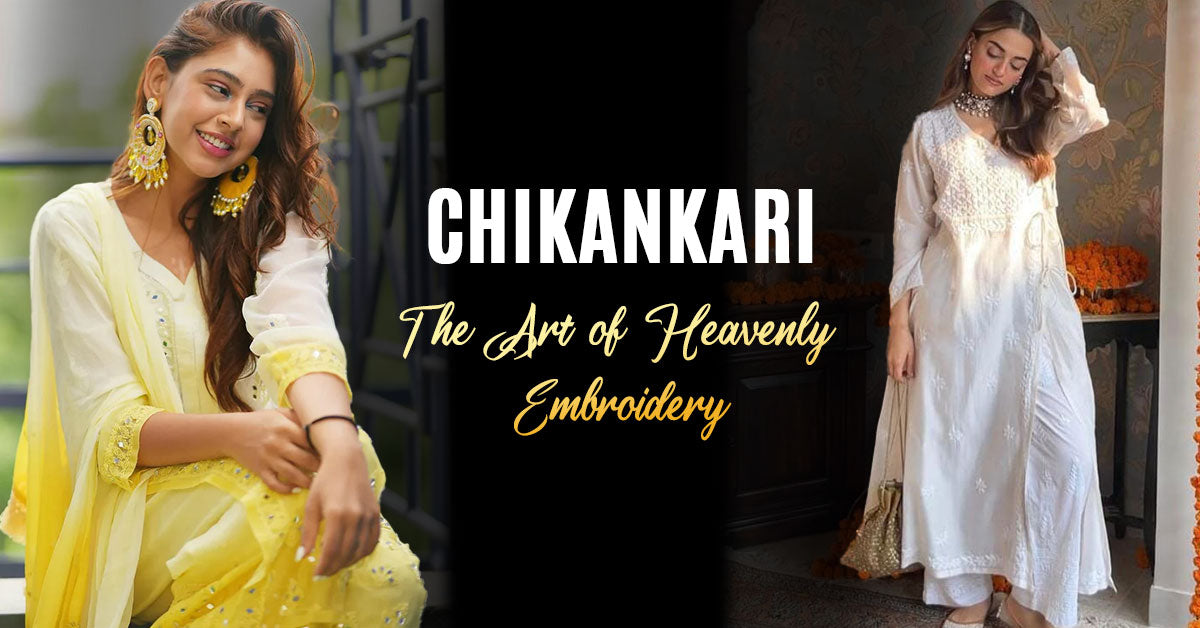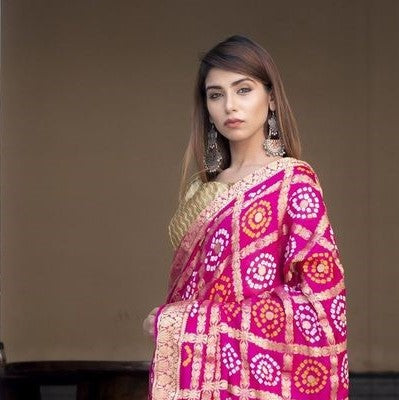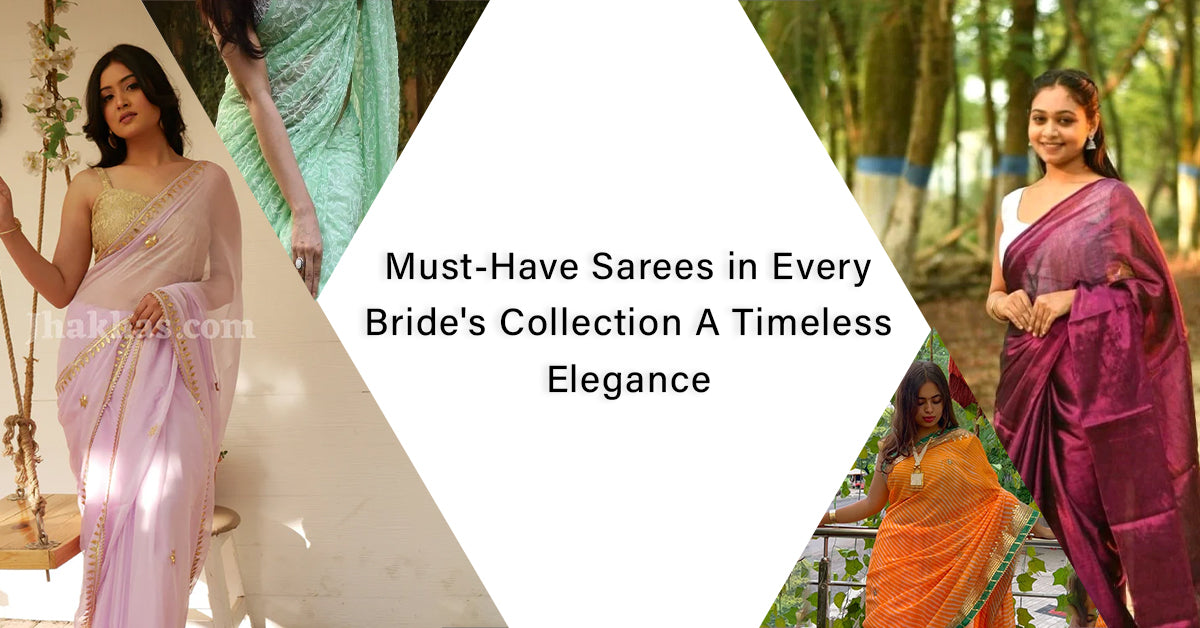Article: Chikankari: The Art of Heavenly Embroidery

Chikankari: The Art of Heavenly Embroidery
Chikankari, a delicate and intricate form of embroidery, is an art that has deeply embedded itself in the cultural fabric of India. More than just a craft, Chikankari is a testament to the rich heritage of Indian textiles. Each thread and stitch tells a story of tradition and craftsmanship, passed down through generations.
Found not just in India but also in other parts of the world, Chikankari is celebrated for its intricate designs, fine threads, and exquisite patterns. Whether adorning a saree, a kurta, or a dupatta, Chikankari adds a touch of sophistication and charm to any attire.

Each piece of Chikankari carries with it the legacy of skilled artisans from India who have dedicated their lives to preserving this beautiful art form. From the bustling streets of Lucknow to the runways of high fashion, Chikankari continues to enchant and inspire, making it a timeless treasure of Indian craftsmanship.
History:
With its earliest mention dating back to the third century BC, Chikankari has created a rich history over the past 400 years. Chikankari was traditionally done on white muslin fabric, known as "malmal," using white thread, but today it is done on a variety of fabrics and with colored threads as well.

One myth associated with Chikankari is that its origin lies in a Persian art form called "Chikeen," which was brought to India by Noor Jahan, the wife of Emperor Jahangir. It is said that she charmed the king with its dreamy white needlework, and thus quickly garnered prominence and imperial patronage. The art form flourished under their shade, with skilled artisans creating exquisite pieces of embroidered clothing for the royal court. Over time, Chikankari became popular among the masses and evolved into a symbol of Lucknow's rich cultural heritage.

Another legend suggests that a traveler named Saadat Ali Khan taught Chikankari to a peasant woman in Lucknow, who then taught it to others in her village.Chikankari was traditionally done on white muslin fabric, known as "malmal," using white thread, but today it is done on a variety of fabrics and with colored threads as well.
There are several types(in numbers-37) of Chikankari embroidery, each with its own unique characteristics. The most common types include:
- Taipchi: Known for its fine, diagonal stitches, Taipchi is used to create intricate patterns and designs on the fabric.
- Jail: Jail involves creating small, square-shaped patterns using a combination of stitches like satin stitch and stem stitch.
- Murri: Murri is a type of stitch used to create small, raised dots on the fabric, giving it a textured look.
- Phanda: Phanda is a knot stitch that is used to create small, circular motifs on the fabric.
- Bakhiya: Bakhiya is a flat stitch that is used to fill in the outlines of the motifs, giving them a raised appearance.

These types of stitches and techniques are used to create beautiful and intricate designs on the fabric, making Chikankari a truly unique and exquisite form of embroidery.
Technique:
The technique involves hand embroidering white thread on white fabric, typically muslin or cotton, to create a shadow effect. The process begins with the design being printed onto the fabric, which is then stretched over a wooden frame called "adda." The embroiderer uses a small, sharp needle called "sujni" to create various stitches, including the backstitch, chainstitch, and hemstitch, among others.

One of the key aspects of Chikankari is its use of white thread on white fabric, giving it a subtle and elegant look. However, colored threads are also used in some variations to create more vibrant designs. The motifs used in Chikankari are often inspired by nature, with common motifs including flowers, leaves, and birds. The embroidery is done on the front side of the fabric, and the back side is usually covered with a layer of running stitches to protect the threads and give the fabric a neat finish.

The intricate and time-consuming nature of Chikankari makes it a labor-intensive art form. It requires great skill and precision, and each piece can take days or even weeks to complete, depending on the complexity of the design. Despite the advent of modern machinery, Chikankari continues to be done entirely by hand, preserving its authenticity and unique charm. Jhakhas promises to bring you the most exquisite and genuine pieces of Chikankari in a wide range of colors.

Significance:
Chikankari holds a special place in Indian culture, especially in the state of Uttar Pradesh, where it is considered a traditional art form. It is not merely a form of embroidery but a symbol of Lucknow city's rich cultural legacy. Historically, Chikankari was patronized by the Mughal emperors and Nawabs of Awadh, who favored its intricate beauty and delicate craftsmanship. This royal patronage elevated Chikankari to a status of prestige and luxury, making it a symbol of aristocracy and refinement.
Beyond its royal associations, Chikankari fabric plays a vital role in various ceremonial and cultural contexts. It is often used in traditional Indian attire, such as sarees, suits, and dupattas, worn during weddings, festivals, and other auspicious occasions. The elegance and grace of Chikankari make it a popular choice for bridal wear, symbolizing purity, beauty, and tradition. The embroidery's intricate patterns and motifs carry deep symbolic meanings, with designs often inspired by nature, mythology, and Mughal architecture.

Chikankari fabric is also deeply intertwined with the social and economic fabric of Lucknow. It provides employment opportunities for skilled artisans, mostly women, who have inherited this craft from generations past. These artisans take great pride in their work, and each piece of Chikankari is a labor of love and dedication.
Chikankari fabric is also significant for its timeless beauty and versatility. The subtle elegance of Chikankari makes it suitable for a wide range of occasions, from casual wear to formal events. The fabric's light and breathable nature make it ideal for India's hot and humid climate, providing both comfort and style.

The embroidery's popularity has transcended regional boundaries, becoming a beloved art form celebrated not just in India but around the world, highlighting its enduring cultural significance.
Trends in Chikankari in 2024:
Chikankari, with its timeless appeal, has witnessed several trends that have kept it relevant in modern fashion. One of the prominent trends is the fusion of traditional Chikankari with contemporary silhouettes. Designers are incorporating Chikankari into Western wear, such as tops, dresses, and even trousers, giving it a fresh and modern twist. This fusion of traditional craft with modern design sensibilities has appealed to a younger audience, making Chikankari more popular among a broader demographic.
Another trend in Chikankari is the use of vibrant colors. While traditional Chikankari was done mainly on white fabric, modern interpretations often feature a variety of colors. Pastel shades, bright hues, and even neon colors are being used to create Chikankari pieces that are bold and eye-catching. This trend has added a new dimension to Chikankari, making it more versatile and suitable for different occasions.

Innovations in stitching techniques have also influenced the trends in Chikankari. While traditional Chikankari is known for its intricate hand-embroidery stitches, modern techniques such as machine embroidery and digital printing are being used to create Chikankari-inspired designs. These techniques allow for faster production and more intricate designs, expanding the range of Chikankari products available in the market.

Lastly, sustainability has become a key trend in the fashion industry, and Chikankari is no exception. With consumers becoming more conscious of the environmental impact of their clothing choices, there is a growing demand for ethically produced and sustainable fashion. Chikankari, with its handcrafted nature and use of natural fibers, aligns well with this trend. Many designers and brands are now promoting Chikankari as a sustainable and eco-friendly choice, further boosting its popularity in the fashion world.
Regional Variations:
While Lucknow is known as the epicenter of Chikankari, the art form is practiced in various other regions of India as well. Each region has its unique style and motifs, making Chikankari a diverse and vibrant art form. Some of the other major centers of Chikankari include Hyderabad, West Bengal each adding its flavor to this timeless embroidery.
The stitches used in Lucknowi Chikankari are often finer and more detailed, with motifs inspired by nature, such as flowers, vines, and birds.
In West Bengal, the Murshidabad region is known for its bold and geometric Chikankari designs. The stitching here is more robust, with larger motifs and a focus on symmetry. The use of bold colors is also more prevalent in this style of Chikankari, giving it a distinct and vibrant look.
In Hyderabad, Chikankari features a blend of Mughal and Persian influences, characterized by intricate floral motifs and elaborate patterns. The stitching in Hyderabadi Chikankari is often dense and closely packed, creating a rich and luxurious texture.

Another variation is the Jaali work, which is a unique style of Chikankari that originated in West Bengal. Jaali work involves creating intricate lace-like patterns by removing threads from the fabric, leaving behind a delicate mesh of embroidered designs.
Overall, the regional variations in Chikankari reflect the diverse cultural influences and craftsmanship found across India, making each style unique and distinctive.
Contemporary Adaptations:
Contemporary designers are embracing the exquisite artistry of Chikankari, infusing their collections with its timeless charm and elegance. Renowned names that rule the Indian fashion industry have all showcased Chikankari in their designs, elevating this traditional craft to a global platform.
Manish Malhotra, known for his opulent and luxurious creations, has beautifully incorporated Chikankari into his bridal and couture collections. While Sabyasachi Mukherjee’s creations feature elaborate Chikankari work, showcasing the art form's intricate patterns and delicate motifs in a modern and stylish avatar. Anita Dongre, most famous for her sustainable and eco-conscious approach to fashion, has made Chikankari a cornerstone of her design philosophy.

These designers' efforts have not only revived interest in Chikankari but have also helped preserve and promote this ancient craft for future generations. Their creations not only celebrate the rich cultural heritage of India but also showcase the timeless beauty and versatility of Chikankari in the modern fashion landscape.
In conclusion, Chikankari is more than just embroidery; it is a reflection of India's rich cultural heritage and artistic tradition. Its timeless appeal and intricate beauty continue to captivate people around the world, making it a cherished art form that has stood the test of time. Whether worn as a bridal ensemble or a casual outfit, Chikankari is a symbol of elegance and grace, embodying the essence of Indian craftsmanship and creativity.


















Leave a comment
This site is protected by hCaptcha and the hCaptcha Privacy Policy and Terms of Service apply.